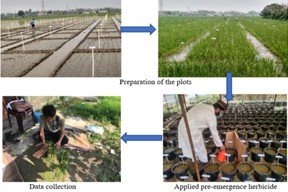Effectiveness of pre-emergence herbicides on weed population and yield of boro rice (cv. BRRI dhan58) under different dose
Abstract
Weed management is crucial for optimal crop performance in rice cultivation. In this respect, an experiment was conducted at the Agronomy Field Laboratory (AFL), Bangladesh Agricultural University (BAU), Mymensingh, from December 2019 to May 2020 and aimed to evaluate the effectiveness of various herbicide treatments on weed management and crop performance in rice cultivation, focusing on the variety BRRI dhan58. The study included a control group and various herbicide treatments: half the recommended dose (RD), RD, and a double dose of pendimethalin, bensulfuron methyl + acetachlor, bensulfuron methyl + bispyribac sodium, pretilachlor, and butachlor. Eleven weed species from six families infested the plots. The results showed that double doses of pre-emergence herbicides resulted in lower weed populations (WP) (m-²), reduced weed dry weight (DW) (gm-2), and higher weed control efficiency (WCE %). The highest weed control efficiencies at 30 DAT were 94.58% for Bensulfuron methyl + Acetachlor and 94.38% for Pretilachlor. The double dose of Bensulfuron methyl + Acetachlor achieved the lowest WP and DW and the highest WCE. Crop performance improved significantly with the double dose of Bensulfuron methyl + Acetachlor, resulting in the highest PH, a more significant number of effective tillers (NET) hill-1, 1000-grain weight (TGW), grain yield (GY), straw yield (SY), biological yield (SY), and harvest index (HI). The second-highest GY was observed with the double dose of Bensulfuron methyl + Bispyribac sodium. The study concluded that the double dose of Bensulfuron methyl + Acetachlor was the most effective weed management strategy, leading to the highest grain yield in boro rice. These findings highlight that using a double dose of Bensulfuron methyl + Acetachlor not only offers superior weed control but also maximizes grain yield, making it the most effective weed management strategy for boro rice cultivation and a practical recommendation for farmers seeking to optimize productivity through targeted herbicide application.
Keywords:
Boro rice, Grain yield, Pre-emergence herbicides, Resistant weeds, Weed control efficiencyDownloads
References
Akondo, S., Ahmed, M. T., Uddin, M. R., & Sarker, U. K. (2024). Combined application of herbicide and aqueous extract of sorghum and mustard crop residue enhance weed management and yield of wheat. Journal of Agroforestry and Environment, 17(2), 1-11. https://doi.org/10.55706/jae1710
Appleby, A. P., & Valverde, B. E. (1989). Behavior of dinitroaniline herbicides in plants. Weed Technology, 3, 198–206. https://doi.org/10.1017/s0890037x00031626
Awan, T. H., Sta Cruz, P. C., & Chauhan, B. S. (2016). Effect of pre-emergence herbicides and timing of soil saturation on the control of six major rice weeds and their phytotoxic effects on rice seedlings. Crop Protection, 83, 37–47. https://doi.org/10.1016/j.cropro.2016.01.013
BBS. (2023). Statistical year book of Bangladesh. Statistics and Information Division, Ministry of Planning, Government of People's Republic of Bangladesh.
BRRI. (2013). Adhunic Dhaner Chash (in Bangla). Bangladesh Rice Research Institute.
Chauhan, B. S., Ahmed, S., Awan, T. H., Jabran, K., & Manalil, S. (2015). Integrated weed management approach to improve weed control efficiencies for sustainable rice production in dry-seeded systems. Crop Protection, 71, 19-24.
Cruz, E. D., Moody, K., & Ramos, M. B. (1986). Reducing variability sampling weeds in upland rice (Oryza sativa). Philippine Journal of Weed Science, 13, 56-59.
Dayan, F. E., Romagni, J. G., & Duke, S. O. (2001). Protoporphyrinogen oxidase inhibitors. In R. Krieger (Ed.), Handbook of pesticide toxicology: Principles and agents (pp. 1529–1541). Academic Press. https://doi.org/10.1016/b978-012426260-7.50071-9
Dola, N. A., Sarker, U. K., Ahmed, M. T., Upama, S. A., Rashid, M. H. O., & Uddin, M. R. (2024). Comparative advantages of aqueous extract of mustard crop residues with herbicide to weed control and crop performance of wheat. Archives of Agriculture and Environmental Science, 9, 294-301. https://doi.org/10.26832/24566632.2024.0902013
FAO & UNDP. (1988). Land resources appraisal of Bangladesh for agricultural development report 2: Agroecological regions of Bangladesh. BARC/UNDP.
Gomez, K. A., & Gomez, A. A. (1984). Statistical procedures for agricultural research (2nd ed.). John Wiley and Sons.
Gotz, T., & Boger, P. (2004). The very-long-chain fatty acid synthase is inhibited by chloroacetamides. Zeitschrift für Naturforschung C: Journal of Biosciences, 59, 549-553. https://doi.org/10.1515/znc-2004-7-818
He, H., Li, Y., Chen, T., Huang, X., Guo, Q., & Li, S. (2013). Butachlor induces some physiological and biochemical changes in a rice field biofertilizer cyanobacterium. Pesticide Biochemistry and Physiology, 105, 224-230. https://doi.org/10.1016/j.pestbp.2013.02.009
IRRI (1965). Annual report for 1963. International Rice Research Institute, Los Banos, Phillippines. P. 467.
Khanh, T. D., Linh, L. H., Linh, T. H., Quan, N. T., Cuong, D. M., Hien, V. T. T., Ham, L. H., & Xuan, T. D. (2013). Integration of allelopathy to control weeds in rice. https://doi.org/10.5772/56035
Mim, T. A., Ahmed, M. T., Sarker, U. K., & Uddin, M. R. (2024). Evaluation of transplanted Aman rice by exploiting and adjusting existing technologies. Archives of Current Research International, 24(8), 43-51.
Mostafa, G., Sarker, U. K., Ahmed, M. T., Salam, M. A., & Uddin, M. R. (2024). Dose response of post-emergence herbicides for prediction of herbicide resistant weeds and yield of Boro rice (cv. BRRI dhan58). Journal of Agroforestry and Environment, 17(2), 28-38. https://doi.org/10.55706/jae1714
Nur-A-Alam, M., Ahmed, M. T., Sarker, U. K., Rahman, M. R., & Uddin, M. R. (2024). Assessing herbicide-resistance and yield optimization in Boro rice (cv. BRRI dhan29) through post-emergence herbicides applications. Asian Journal of Research in Crop Science, 9(3), 22-36.
Onwuchekwa-Henry, C. B., Van Ogtrop, F., Roche, R., & Tan, D. K. Y. (2023). Efficacy of pendimethalin rates on barnyard grass (Echinochloa crus-galli L.) Beauv and their effect on photosynthetic performance in rice. Agronomy, 13, 582. https://doi.org/10.3390/agronomy13020582
Onwuchekwa-Henry, C. B., Van Ogtrop, F., Roche, R., & Tan, D. K. Y. (2022). Seeding rate, fertilizer and herbicide effects on canopy growth and productivity of direct-seeded rice (DSR) under different management practices. Field Crops Research, 284, 108565. https://doi.org/10.1016/J.FCR.2022.108565
Proceedings of ISWS Biennial Conference on “Weed Management for Enhancing Farmers' Income and Food Security”, ICAR-CCARI, Goa, Indian Society of Weed Science, India. 5-7 February 2020, 270 p.
Rahman, M., Sarker, U. K., Ahmed, M. T., Zinnat, M., & Uddin, M. R. (2024). Combined hot water extract of lentil and grass pea increases weed control efficiency and yield of boro rice. Archives of Agriculture and Environmental Science, 9(3), 500-507. https://doi.org/10.26832/24566632.2024.0903013
Ryu, J.-H., Jeong, H., & Cho, J. (2020). Performances of vegetation indices on paddy rice at elevated air temperature, heat stress, and herbicide damage. Remote Sensing, 12, 2654. https://doi.org/10.3390/rs12162654
Stickler, R. L., Knake, E. L., & Hinesly, T. D. (1969). Soil moisture and effectiveness of preemergence herbicides. Weed Science, 17, 257-259. https://doi.org/10.1017/s0043174500031453
Tonni, N. H., Sarker, U. K., Ahmed, M. T., Upama, S. A., & Uddin, M. R. (2024). Relative benefits of aqueous extract of sorghum residues with herbicide on weed control and yield of wheat varieties. Journal of Bangladesh Agricultural University, 22(3), 326-334. https://doi.org/10.3329/jbau.v22i3.76405
Yang, W., & Holmen, B. A. (2007). Effects of relative humidity on chloroacetanilide and dinitroaniline herbicide desorption from agricultural PM2.5 on quartz fiber filters. Environmental Science & Technology, 41, 3843-3849. https://doi.org/10.1021/es062692i
Yunus, M., Rashid, S., & Chowdhury, S. (2019). Per capita rice consumption in Bangladesh: Available estimates and IFPRI’s validation survey results. International Food Policy Research Institute.
Zinnat, M., Ahmed, M. T., Sarker, U. K., Rahman, M., & Uddin, M. R. (2024). Influence of grass pea residues extract on weed control efficacy and performance of boro rice. Journal of Bangladesh Agricultural University, 22(3), 360-368. https://doi.org/10.3329/jbau.v22i3.76409

Published
How to Cite
Issue
Section
Copyright (c) 2024 Agriculture and Environmental Science Academy

This work is licensed under a Creative Commons Attribution-NonCommercial 4.0 International License.

